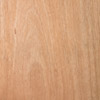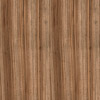ALDER
Alder wood is used in more guitar bodies than any other species. Alder is a common name for genus Alnus, which is part of the birch family Betulaceae family. Alder is a fast-growing hardwood. It grows throughout the northern hemisphere in the temperate zone. There are many varieties. For our purposes, Alnus rubra, or red alder, is the variety of interest. Red alder grows on the US west coast and is the dominant species used for electric guitar bodies. Like ash, alder is often used on its own as a body wood (that is, it is not usually topped/capped with another wood as often happens with mahogany). Guitar bodies made from alder typically consist of two to four pieces glued together (though there are single piece alder bodies – at Alloy Guitars we offer them!). Alder is easy to work with and it glues well. Alder takes finishes well. It has a light brown color and a tight grain that is not terribly prominent, making it ideal for solid colors rather than the transparent finishes that look so good on some ash bodies. Alder’s grain might not be particularly interesting, but it is generally straight and clean looking. It is typically used under opaque finishes, but some examples can look good under darker translucent finishes. Alder is a medium weight, closed pore wood. Weight does vary, however, and some alder used for guitar bodies may weigh less than denser cuts of ash. Due to its widespread popularity, it produces a familiar tone. Alder bodies are resonant, and have a strong, clear, full-bodied sound, with beefy mid-range sounds and excellent lows. These bodies are very full in the low midrange yet produce clear and articulate higher frequencies. Alder bodies offer a fair amount of sustain. As with ash, it’s impossible to discuss the use of alder in guitars without talking about Fender. Fender has used alder since the 1950s. This wood was readily available and less expensive than ash (particularly the swamp ash that produces the best instruments). It is now the body wood for many of Fender guitars and bases.
| Scientific Name: |
Alnus rubra |
| Location: |
Coastal Western North America |
| Average Dried Weight: |
28 lbs/ft3 |
|
| Used as Body Base |
 |
| Used as Lam Top |
 |
| Used as Carved Top |
 |
|
SWAMP ASH
Like alder, swamp ash is a classic solid body guitar wood. There are many kinds of ash trees. For use in electric guitar bodies, the American ash species – Fraxinus Americana – is the one in prominent use. American Ash is a native North American hardwood found on the eastern half of the continent. The wood is strong, dense, straight-grained and light in color. In addition to guitar bodies, ash is used for flooring, furniture, baseball bats, and many other items. For guitar bodies, two sub species are used: northern ash and southern or “swamp” ash. Northern ash is harder and heavier. As a guitar body, it produces more treble and sustain, with less warmth than other guitar woods. In some cases, it makes for bodies that are quite heavy! These bodies have a brighter sound that might be more useful when sharper tones are desired. Swamp ash is lighter in weight. Typically, the wood is taken from the lower portions of wetland trees that have root systems below water level. The wood has beautiful grain that is perfect for transparent or lightly colored finishes that let the wood grain show through. The wood is light in color, highlighted by brown grain patterns. This wood looks awesome with natural finishes and transparent colors. Swamp ash wood has large open pores, making it resonant and sweet sounding, with great highs, solid well-defined midrange, and a strong low end. Swamp ash sound is articulate, with a great balance between brightness and warmth. In contrast to alder’s even and consistent tonal properties due to its tight, consistent grain, the open grain and varied grain structure of swamp ash means that two swamp ash bodies may differ from one another tonally. Swamp ash is often used for guitar bodies for its sonic characteristics and for its light weight. For these reasons, it is more commonly used than any other ash species. Often, two or three pieces are glued together to make an instrument body, although there are single-piece bodies (we offer them at Alloy Guitars!).
| Scientific Name: |
Fraxinus americana |
| Location: |
Eastern North America |
| Average Dried Weight: |
42lbs/ft3 |
|

| Used as Body Base |
 |
| Used as Lam Top |
 |
| Used as Carved Top |
 |
|
BASSWOOD
Basswood is affordable and abundant. It has become particularly associated with mid- or budget-level guitars. Basswood was particularly popular in the 1980s. Basswood is a good tonewood and many guitar makers have had excellent results using it. It is a very light and soft wood, and it is light in color. It has minimal grain. Solid basswood bodies have a fat, well-balanced tone. There’s a muscular midrange. On a well-made guitar, basswood can yield good tone and dynamics, with good definition. It may be less expensive than its big brothers (alder and ash), but that doesn’t mean that it shouldn’t see more use!
| Scientific Name: |
Tilia americana |
| Location: |
Eastern North America |
| Average Dried Weight: |
26 lbs/ft3 |
|

| Used as Body Base |
 |
| Used as Lam Top |
 |
| Used as Carved Top |
 |
|
MAHOGANY
Mahogany is a wood that became popular primarily in the electric guitar world due to being used on Gibson guitars since the 1950s. (It is also used heavily in acoustic instruments.) There are many species of tree that are called “mahogany” (some accurately, some not so much). Typically, in guitar construction, mahogany means Central American Honduran mahogany or African mahogany. Here at Alloy Guitars, we sell both of these varieties.
Mahogany is a dense, medium weight wood that yields a wide range of guitar body weights, depending upon the source of the wood. Medium brown in color with a red or orange hue, this mid weight wood has a mild grain pattern that looks great with many transparent finishes. Mahogany’s tone is warm and a bit soft, but overall is well balanced. There is usually good depth to the sound, with full but not especially tight lows, and appealing if unpronounced highs. Its tone is thick and concentrated with a forceful midrange. Mahogany is a classic ingredient in slab, carved top, and laminated bodies. It is also a common neck wood (see below). Mahogany is used in single-wood bodies, too. Gibson Les Paul Jr., Les Paul Special, and SG were made of solid mahogany, and guitar builders have used the wood in many solid and semi-solid designs over the years. Mahogany with Maple. This is the most popular laminated or carved-top body type. Adding a maple top to a solid mahogany back yields a guitar body that exhibits many of the best tonal properties of both woods. The mahogany and maple body is rich, warm, and resonant with mahogany’s lows and good sustain, augmented by the maple top’s clarity and definition.
| African Mahogany |
| Scientific Name: |
Khaya spp. (Khaya anthotheca, K. grandifoliola, K. ivorensis, K. senegalensis) |
| Location: |
West tropical Africa |
| Average Dried Weight: |
40 lbs/ft3 |
| True Honduran Mahogany |
| Scientific Name: |
Swietenia macrophylla |
| Location: |
Southern Mexico to central South America |
| Average Dried Weight: |
37 lbs/ft3 |
|
 
| Used as Body Base |
 |
| Used as Lam Top |
 |
| Used as Carved Top |
 |
|
PINE
Pine, particularly knotty pine, can make for dramatic looking guitars. Fender has made knotty pine Telecasters on occasion and they are striking.
| Scientific Name: |
|
| Location: |
North America |
| Average Dried Weight: |
lbs/ft3 |
|

| Used as Body Base |
 |
| Used as Lam Top |
 |
| Used as Carved Top |
 |
|
CEDAR
Cedar can make for some very beautiful bodies! These are not used regularly, however.
| Scientific Name: |
|
| Location: |
North America |
| Average Dried Weight: |
lbs/ft3 |
|

| Used as Body Base |
 |
| Used as Lam Top |
 |
| Used as Carved Top |
 |
|
REDWOOD
Redwood can make for some very beautiful bodies! These are not used regularly, however.
| Scientific Name: |
|
| Location: |
North America |
| Average Dried Weight: |
lbs/ft3 |
|

| Used as Body Base |
 |
| Used as Lam Top |
 |
| Used as Carved Top |
 |
|
Black Korina / Black Limba.
Black Korina, or Black Limba has been used successfully as a base body wood in many guitars. Most notably, Gibson has used this wood in various models.>/p>
| Scientific Name: |
Terminalia superba |
| Location: |
Tropical western Africa |
| Average Dried Weight: |
35 lbs/ft3 |
|

| Used as Body Base |
 |
| Used as Lam Top |
 |
| Used as Carved Top |
 |
|
Walnut
Walnut is becoming a more popular choice for fingerboards and finds its way into the guitar body world too. Walnut range from a lighter pale brown to a dark chocolate brown with darker brown streaks. Color can sometimes have a grey, purple, or reddish cast.
Walnut is used for both neck shaft and fingerboards.
| Scientific Name: |
Juglans nigra |
| Location: |
Eastern United States |
| Average Dried Weight: |
38 lbs/ft3 |
|

| Used as Body Base |
 |
| Used as Lam Top |
 |
| Used as Carved Top |
 |
|
Poplar
Poplar is light cream to yellowish brown, with occasional streaks of gray or green. It is lightweight and makes good guitar bodies. The grain patterns and colors are not generally amenable to clear finishes, but they make fine painted bodies!
| Scientific Name: |
Liriodendron tulipifera |
| Location: |
Eastern United States |
| Average Dried Weight: |
29 lbs/ft3 |
|

| Used as Body Base |
 |
| Used as Lam Top |
 |
| Used as Carved Top |
 |
|
Zebrawood
Also known as Zebrano, Zebrawood is a light brown or cream color with dark blackish brown streaks vaguely resembling a zebra’s stripes. The stripes can be either chaotic and wavy when flatsawn, or somewhat uniform when quartersawn.
| Scientific Name: |
Microberlinia brazzavillensis |
| Location: |
West Africa |
| Average Dried Weight: |
50 lbs/ft3 |
|

| Used as Body Base |
 |
| Used as Lam Top |
 |
| Used as Carved Top |
 |
|











